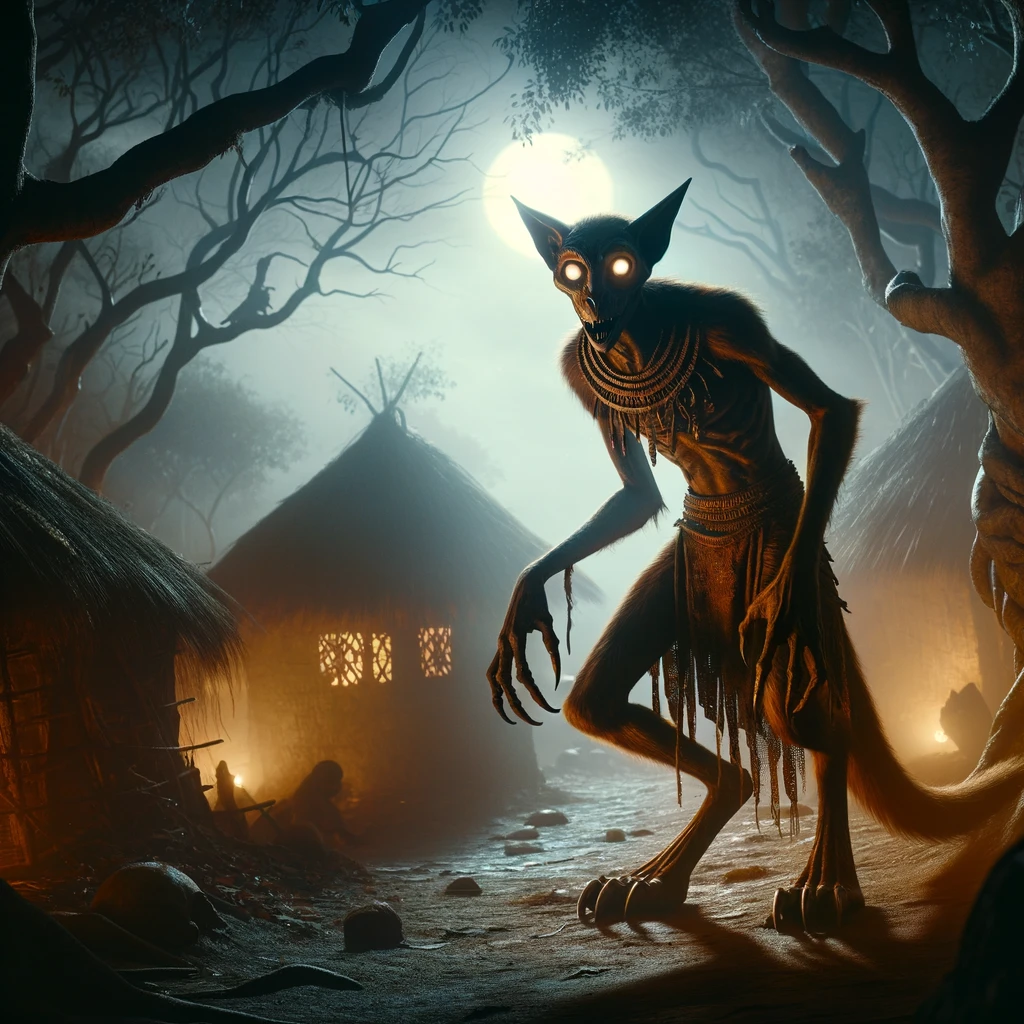In the rich mosaic of African folklore, where each creature and spirit carries a story woven into the fabric of cultural heritage, the Ufiti stands out as a particularly intriguing figure. This lesser-known entity, shrouded in mystery and fear, occupies a unique place in the folklore of several African communities. The Ufiti is often depicted as a night creature or a witch’s familiar, embodying the darker aspects of the supernatural world.
Nature and Powers of the Ufiti
The Ufiti is believed to possess formidable supernatural powers, including shape-shifting abilities that enable it to assume various forms. Traditionally, it is described as having a humanoid shape with distinct animalistic features such as elongated limbs, sharp claws, and unnervingly glowing eyes. These eyes, capable of piercing through the deepest darkness of African nights, are perhaps the most striking and feared aspect of the Ufiti.

Said to roam forests and villages under the cover of night, the Ufiti executes the malevolent will of its witch master. Its presence is often associated with ominous events, from mysterious illnesses to unexplained misfortunes befalling individuals or entire communities. The Ufiti’s ability to move unseen, except for its glowing eyes, adds to its reputation as an elusive and terrifying specter.
Cultural Significance
The cultural significance of the Ufiti extends beyond its role as a mere harbinger of doom. In many stories, the Ufiti serves as a cautionary figure, a representation of the consequences of meddling with dark forces. Tales of the Ufiti are told to warn against the dangers of straying from the moral path and to teach the importance of respecting the spiritual world’s boundaries.
Moreover, the Ufiti highlights the complex relationship between humans and the supernatural in African folklore. It underscores the belief in a world where the material and spiritual realms are closely intertwined, and actions in one can have profound effects on the other. The Ufiti, therefore, embodies the fears and uncertainties that come with this interconnected existence.
Sightings
Accounts of encounters with the Ufiti, a creature steeped in the mystique of African folklore, are as intriguing as they are rare. These sightings, passed down through generations or whispered among the members of communities, paint a vivid picture of a creature that dwells in the liminal spaces between the known and the unknown. While concrete evidence of the Ufiti’s existence remains elusive, the stories persist, a testament to the creature’s enduring presence in the collective imagination.
Many reported sightings of the Ufiti occur at night, under the cloak of darkness that the creature is said to prefer. Witnesses often describe a chilling sensation, a feeling of being watched, before catching a glimpse of glowing eyes in the shadows. These eyes, unnaturally bright and imbued with an intelligence that is unsettling, are the most common detail shared by those who claim to have seen the Ufiti.
In regions where dense forests form the backdrop of daily life, the Ufiti is said to roam. Hunters and gatherers speak of moments when the forest falls unnaturally silent, a silence that is almost palpable, heralding the presence of the Ufiti. Some have reported seeing figures moving swiftly between the trees, too quick to be human, with a grace that belies their malevolent reputation.
The Ufiti is also believed to guard the thresholds between the physical and spiritual worlds. Sightings near burial sites or sacred spaces are particularly common, with the Ufiti acting as a sentinel. These encounters are often accompanied by a sense of dread or awe, as if those who witness the Ufiti at these liminal sites are granted a fleeting connection to the mysteries of the afterlife.
In the modern era, sightings of the Ufiti have not waned. Instead, they have transformed, moving from the secluded villages and deep forests into the urban tales of the night. Taxi drivers, night-shift workers, and others who traverse the city after dark recount stories of encountering a figure that defies explanation, a reminder that the Ufiti, like the folklore from which it springs, adapts and endures.
In contemporary times, the legend of the Ufiti continues to evolve, reflecting changes in societal attitudes and concerns. While still a figure of fear, the Ufiti also represents the enduring power of traditional beliefs in an increasingly globalized world. Modern retellings of the Ufiti’s tale sometimes explore themes of environmental degradation, social injustice, and the loss of cultural identity, demonstrating the adaptability and relevance of folklore in addressing contemporary issues.
The Ufiti’s story is a testament to the enduring nature of folklore as a means of understanding the world and our place within it. Through the figure of the Ufiti, we are reminded of the mysteries that lie just beyond the edge of the firelight, the untold stories that flutter in the shadows, and the lessons that the past continues to teach us about the complexities of human nature and the unseen forces that shape our lives.


















